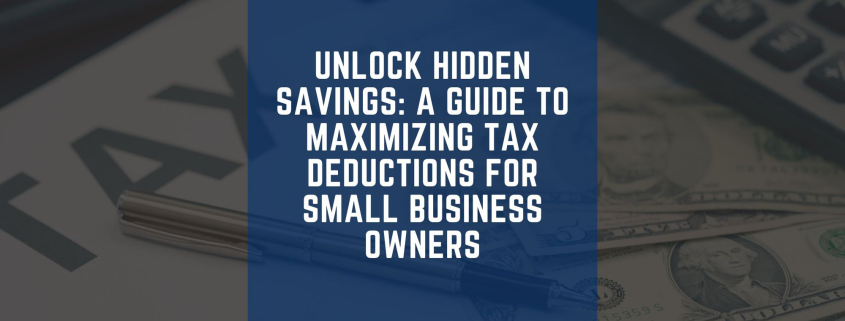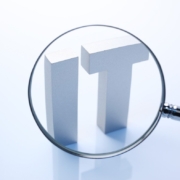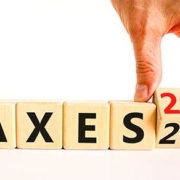Unlock Hidden Savings: A Guide to Maximizing Tax Deductions for Small Business Owners
- Learn how to get the most out of your tax deductions.
- Understand what you can deduct.
As a small business owner, your goal should be maximizing tax deductions to minimize your liability. Effective tax planning can greatly impact your bottom line, allowing you to reinvest more into your business. This guide covers strategies and deductions available to small business owners, including those for new businesses and legal fees. It also covers spousal joint ventures, self-employed health insurance, home offices, business equipment, and advertising expenses. Additional topics include website costs, financing, vehicle expenses, entertainment, depreciation, and material and supply expensing. The guide also covers de minimis safe harbor expensing, routine maintenance, bonus depreciation, and Section 179 expensing. Finally, it discusses business meals, the qualified business income deduction, and the TCJA sunsetting after 2025.

New Businesses
Starting a new business involves various costs, many of which can be deducted to reduce your taxable income. The costs of starting a company must be amortized over 15 years. However, you can deduct up to $5,000 of start-up expenses and $5,000 of organizational expenses in the first year. Qualified start-up costs include:
- Surveys/analyses of potential markets, labor supply, products, transportation facilities, etc.
- Wages paid to employees, and their instructors, while they are being trained.
- Advertisements related to opening the business.
- Fees and salaries paid to consultants or others for professional services; and
- Travel and related costs to secure prospective customers, distributors, and suppliers.
Each of the $5,000 amounts is reduced by the amount by which the total start-up expenses or organizational expenses exceed $50,000. Expenses not deductible in the first year of the business must be amortized over 15 years.
Legal and Professional Fees
Legal and professional fees for setting up your business qualify for a $5,000 first-year deduction under organizational expenses. The remaining balance can be amortized over 15 years. After your business starts, these fees are expensed as incurred. This includes costs for legal advice, accounting services, and consulting fees. These services are vital for compliance and optimizing business operations.
Spousal Joint Ventures
Where a business is established by a married couple, a fundamental choice to be made is whether one spouse will be the sole proprietor and the other will be on the payroll or if the business will be a partnership where each spouse will report their share of income, gain, loss, deduction, and credit on a separate Schedule C or F(this choice is not available for Schedule E rental property) treating the business as a qualified joint venture.
If separate, make sure that the participating spouse is put on the payroll of the sole proprietorship (which also allows the employee-spouse to accumulate Social Security benefits). Both spouses must have earned income on a joint return to claim a childcare credit. Imputed income counts if one spouse is a full-time student or disabled. If the non-Schedule C spouse lacks earned income, the couple may lose the childcare credit. To fix this, establish a partnership or joint venture.
Self-Employed (SE) Health Insurance
Self-employed individuals can deduct 100% of health insurance premiums for themselves, spouses, and dependents. This deduction is above the line, reducing adjusted gross income (AGI). The deduction is limited to the business's net income. SE health insurance deduction is allowed even if using the standard deduction.
Self-Employment Tax Deduction
Sole proprietors with profits must pay self-employment tax, contributing to Social Security and Medicare. There's a deduction for this tax. Self-employed individuals can deduct 50% of their SE tax liability as an above-the-line deduction. You do not need to itemize deductions to claim this.
Insurance
Insurance premiums necessary for your business operations are deductible for sole proprietors. This includes health, liability, property, and auto insurance for business-use vehicles to the extent of business use.
Home Office
Small business owners can qualify for a home-office deduction to save on taxes and improve their bottom line. To qualify, a portion of the home must be used exclusively and regularly for business. Both homeowners and renters are eligible. There are two methods to determine the home-office deduction amount:
- Actual-Expense Method – The actual expense method prorates home expenses based on the portion of the home that qualifies as a home office, which is generally based on square footage. Aside from prorated expenses, 100% of directly related costs, such as painting and repair expenses specific to the office, can be deducted. Unlike the simplified method, the business-use percentage for the calculation is not limited to 300 square feet.
- Simplified Method – The simplified method allows for a deduction equal to $5 per square foot of the home used for business, up to a maximum of 300 square feet, resulting in a maximum simplified deduction of $1,500.
A taxpayer can choose between the simplified method and the actual expense method annually, switching methods each year. Using the simplified method, you do not account for home office depreciation when selling the home. Additional office expenses like utilities and insurance are not allowed with the simplified method. Prorated rent, home interest, and taxes are also excluded, though 100% of qualified mortgage interest and real property taxes may be deductible if itemized.
Qualified Business Income Deduction
The TCJA introduced the Qualified Business Income (QBI) deduction, allowing up to 20% deduction of qualified business income. This deduction has various limitations and phase-outs based on income levels and business types. Planning is key to maximizing this deduction.
Advertising Expenses
Once operational, all advertising expenses are generally deductible, including business cards, digital ads, and print ads. Advertising expenses before business start-up are treated as start-up expenses. Custom trade show booths can be mostly or fully expensed using bonus depreciation or Sec 179.
Website Costs
Website development and maintenance costs are deductible. Initial development costs are amortized over three years, while maintenance is expensed yearly. A well-maintained website is vital for attracting and retaining customers.
Financing
Interest on business loans is deductible, reducing taxable income. This includes loans for equipment, real estate, or other business needs. Manage financing to optimize cash flow and support growth. Avoid mixing personal and business interest expenses, as doing so could lead to confusion as to the amount of deductible business interest.
Vehicle Expenses
For business use, deduct car expenses using either the standard mileage method or actual expense method. Both require tracking business and total mileage. The standard mileage method uses a per-mile amount, while the actual method prorates operating expenses. Tolls and parking fees are deductible with both methods.
- Record Keeping – Both the standard mileage and the actual expense methods offer unique advantages and requirements, but one common thread is the necessity of meticulous record keeping. To claim the standard mileage rate, you must be able to substantiate the business use of your vehicle. This means keeping a detailed log of each trip, including the date, destination, purpose, and miles driven.
- Business vs. Personal Use – If you use your vehicle for both business and personal purposes, you must allocate expenses based on the percentage of business use. Accurate records of both business and personal mileage are essential to calculate this percentage correctly.
In the event of an IRS audit, your mileage log serves as evidence to support your deduction claims. Without proper records, you risk having your deductions disallowed, which could result in additional taxes, penalties, and interest.
Meal Deductions
Meal expenses are deductible under certain conditions. These expenses must be ordinary and necessary for carrying on a trade or business, and not lavish under the circumstances. However, the percentage of a qualified business meal that is deductible has varied in recent years.
- Before 2021 – Businesses were only allowed to deduct 50% of the cost of a qualified meal.
- 2021 and 2022 – In response to the COVID-19 pandemic, the Consolidated Appropriations Act, of 2021, introduced a temporary provision allowing a 100% deduction for business meals provided by restaurants. The aim was to support the struggling restaurant industry by encouraging businesses to spend more on qualified meals.
- After 2022, the allowable deduction has reverted to 50% of the cost of a qualified meal.
Qualified meal deductions are basically in two categories, business meals and away-from-home meals:
- Business Meals The taxpayer or an employee must be present at the meal. Additionally, the meal must be provided to a current or potential business customer, client, consultant, or similar business contact.
- Away From Home Meals When there is travel away from home on business, the traveler may deduct 50% of the cost of their meals. For instance, if a self-employed individual goes on a business trip and incurs meal expenses, they can deduct 50% of those costs. If they dine with a business contact and pay for that person’s meal, they can also deduct 50% of the cost of the contact's meal. The temporary 100% deduction for restaurant-provided meals in 2021 and 2022 also applied to away-from-home meals.
Instead of actual meal costs, self-employed individuals can use an optional rate method, also called the standard meal allowance, in effect for the year, with the rate generally higher for major cities, resort areas, and other locations in the U.S. The per diem rates for 2024 range from a low of $59 to $79. The applicable rates can be found at the following website: www.gsa.gov/perdiem
Recordkeeping and Compliance
To claim business meal deductions, taxpayers must maintain detailed records. This includes keeping receipts, invoices, or other documentation that substantiates the expense. The IRS requires that the records indicate the amount, date, location, and business purpose of the meal, as well as the identities of the individuals involved.
Entertainment
The Tax Cuts & Jobs Act (TCJA) essentially eliminated the deduction for most entertainment expenses, but you can still deduct 50% of business meals if they are directly related to your business. This includes meals with clients, prospects, and employees. Proper documentation is essential to substantiate these deductions.
Away From Home Lodging Expenses
Self-employed individuals are not entitled to use the federal per diem rates to substantiate lodging expenses under any circumstances. There is no optional standard lodging amount like the standard meal allowance. The allowable lodging expense deduction is the taxpayer’s actual cost as documented by receipts.
Deducting the Cost of Business Supplies and Equipment
From time to time, an owner of a small business will purchase equipment, office furnishings, vehicles, computer systems, and other items for use in the business. How to deduct the cost for tax purposes is not always an easy decision because there are several options available, and the decision will depend upon whether a big deduction is needed for the acquisition year or more benefits can be obtained by deducting the expense over several years using depreciation. The following are the write-off options currently available.
Material & Supply Expensing
IRS regulations allow certain materials and supplies that cost $200 or less, or that have a useful life of less than one year, to be expensed (deducted fully in one year) rather than depreciated. This simplifies accounting and provides immediate tax benefits for necessary business purchases.
De Minimis Safe Harbor Expensing
The de minimis safe harbor rule allows businesses to expense purchases up to $2,500 per item or invoice, or $5,000 if the business has an applicable financial statement. This rule simplifies record-keeping and provides flexibility in managing smaller capital expenditures.
Routine Maintenance
IRS regulations allow a deduction for expenditures used to keep a unit of property in operating condition where a business expects to perform the maintenance twice during the class life of the property. Class life is different than depreciable life. Here are examples of the class life and depreciable life differences for some items commonly used in business:
Depreciation
Depreciation is the normal accounting way of writing off business capital purchases by spreading the deduction of the cost over several years. The IRS regulations specify the number of years for the write-off based on established asset categories, and generally for small business purchases the categories include 3-, 5- or 7-year write-offs. The 5-year category includes autos, small trucks, computers, copiers, and certain technological and research equipment, while the 7-year category includes office fixtures, furniture, and equipment. The cost of nonresidential real property (buildings) used in business is depreciated over 39 years.
Bonus Depreciation
The tax code provides for a first-year bonus depreciation that allows a business to deduct 100% of the cost of most new or used tangible property if it is placed in service during 2022. This provides a larger first-year depreciation deduction for the item. Bonus depreciation is a temporary provision and for eligible business property bought after 2022, the rates drop to 80% in 2023, 60% in 2024, 40% in 2025, 20% in 2026, and nothing after 2026. When the bonus depreciation rate is less than 100%, the difference between the cost of the item and the bonus write-off amount is eligible for regular depreciation.
Sec 179 Expensing
Another option provided by the tax code is an expensing provision for small businesses that allows a certain amount of the cost of tangible equipment purchases to be expensed in the year the property is first placed into business service. This tax provision is commonly referred to as Sec. 179 expensing, named after the tax code section that sanctions it. The expensing is limited to an annual inflation-adjusted amount, which is $1,220,000 ($610,000 for taxpayers filing as married separately) for 2024.
Mixing Bonus and Section 179 Expensing
Businesses can combine bonus depreciation, regular depreciation, and Section 179 expensing to maximize deductions. This flexibility allows businesses to tailor their tax strategy to their specific needs, optimizing cash flow and tax savings.
Retirement Plans
Contributions to retirement plans, such as SEP IRAs or solo 401(k)s, are deductible. These plans allow for significant contributions, reducing taxable income while saving for retirement. For example, in 2024, the contribution limit for a SEP IRA is up to 25% of compensation (20% of the net business profit) or $69,000, whichever is less. If you have employees, your contributions to their retirement plans are deductible from your business income. However, your contributions to your plan, while deductible from your adjusted gross income, are not an expense of your self-employment business.
Retirement Start-Up Credit
Where a small employer does not already have a retirement plan, there is a tax credit for the costs of establishing a retirement plan, up to $500 per year per eligible employee for the first three years of the plan, a maximum of $5,000 per year. This can include setup and administrative costs.
Employee Payroll
Wages paid to employees, including salaries, bonuses, commissions, and certain fringe benefits, are deductible business expenses. This encompasses all forms of compensation given to an employee for services performed, regardless of how the compensation is measured or paid. In addition. employers can also deduct the costs associated with payroll taxes. These taxes include the employer's share of Social Security and Medicare taxes, federal unemployment taxes (FUTA), and state unemployment taxes.
Hiring Your Children
Where they can provide meaningful services, hiring your children can be a smart move for both your business and your family. Not only does it provide your children with valuable work experience and instill a strong work ethic, but it also offers significant tax advantages. By employing your children, you can shift income from your higher tax bracket to their lower one, potentially reducing your taxable income and saving on taxes. Make sure to keep careful records of the hours and services rendered by your children should the business ever be audited.
Research Credit
The Research and Development (R&D) Tax Credit allows businesses to deduct expenses related to research and development activities. This can include wages, supplies, and contract research expenses. For a sole proprietor developing a new product, the costs associated with design, testing, and prototyping could be eligible for this credit.
Accountant and Bookkeeping Fees
Including those related to tax preparation, payroll services, bookkeeping, and other financial management activities, are generally deductible expenses for businesses. These costs are considered necessary and ordinary expenses incurred in the operation of a business.
- Business owners need to maintain detailed records of these expenses to substantiate their deductions during tax filing. Consulting with a tax professional can provide further insights into how to maximize these deductions while adhering to the IRS guidelines.
Effects of TCJA Sunsetting After 2025
Many provisions of the TCJA, including the QBI deduction and increased bonus depreciation, are set to expire after 2025. Business owners should be aware of these changes and plan accordingly. Strategies may include accelerating deductions and income recognition to take advantage of current tax benefits before they expire.
Maximizing business deductions requires careful planning and a thorough understanding of the tax code. By leveraging available deductions and credits, small business owners can significantly reduce their tax liability and reinvest savings into their businesses.
If you have questions or need assistance, schedule a consultation with a Fiducial advisor at https://fiducial.com/consultations.
Know someone who might need our services? We love referrals!









